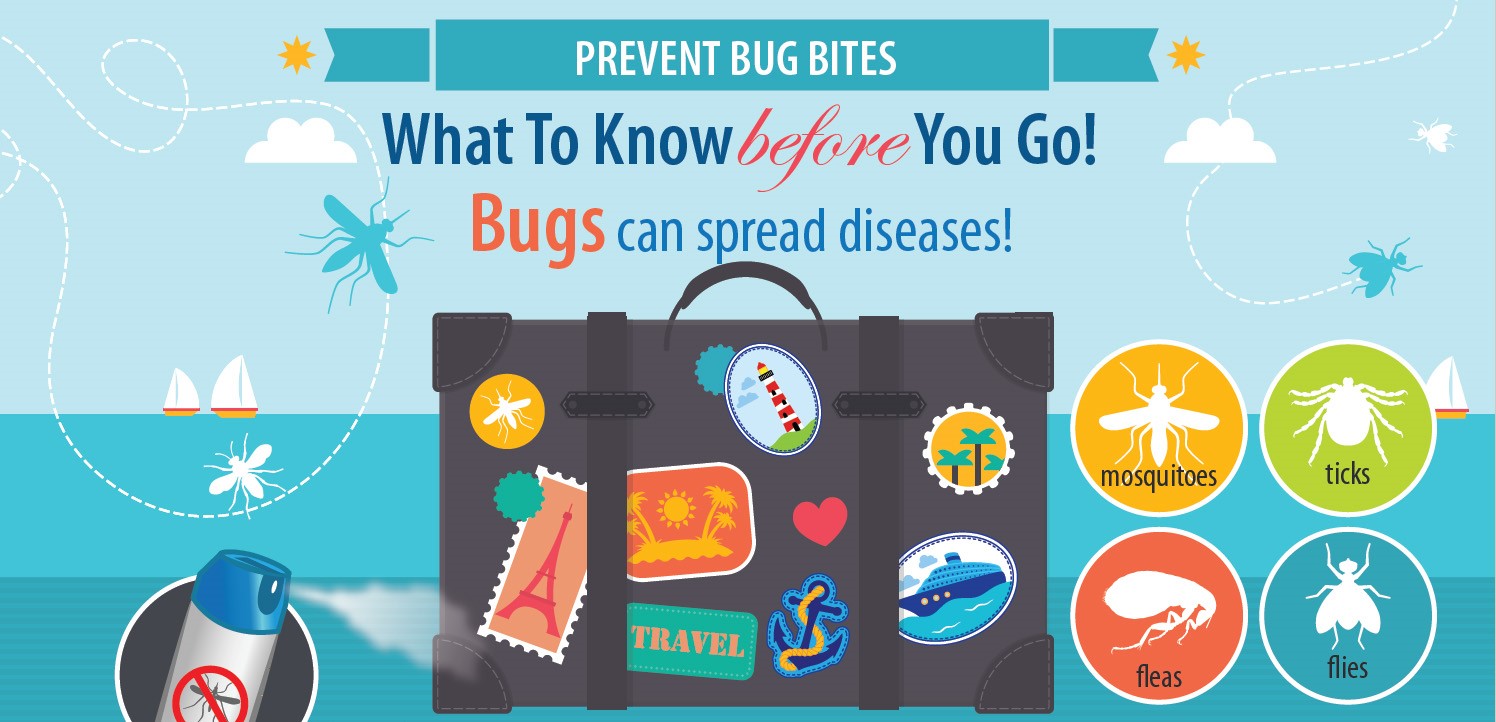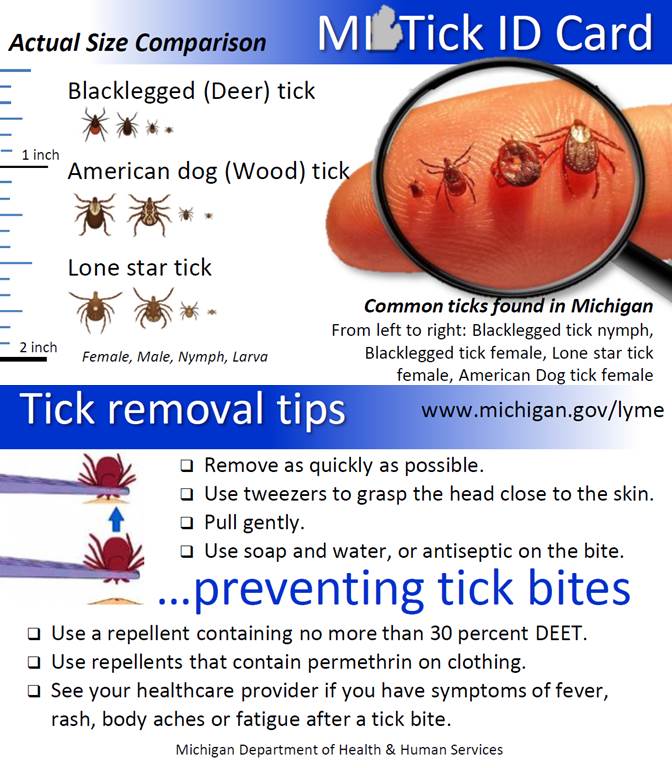It’s bug season in Michigan! Unfortunately, bugs like mosquitoes and ticks as well as animals and bacteria can spread diseases that most often can be prevented.
Ticks
According to the Center for Disease Control and Prevention (CDC), Lyme disease is caused by bacteria called Borrelia burgdorferi and is transmitted to humans through the bite of infected blacklegged ticks, sometimes referred to as deer ticks. Typical symptoms include fever, headache, fatigue, and a characteristic skin rash called erythema migrans, often in the shape of a bullseye. People suspected of exposure to Lyme’s Disease should contact their healthcare provider or local DHD#10 office as soon as possible. An interview will be conducted by a public health nurse to understand what happened at the time of the bite.
If left untreated, infection can spread to joints, the heart, and the nervous system. Lyme disease is diagnosed based on symptoms, physical findings (e.g., rash), and the possibility of exposure to infected ticks. Laboratory testing is helpful if used correctly and performed with validated methods. Most cases of Lyme Disease can be treated successfully with a few weeks of antibiotics.
Exposure to ticks is highest in the woods and in the edge area between lawns and woods; however, ticks can also be carried by animals onto lawns and gardens and into houses by pets. It is important to perform daily tick checks on both humans and pets and remove any attached ticks with tweezers. It is also suggested that after coming indoors, bathe or shower as soon as possible and tumble dry clothing in a hot dryer for 10 minutes to kill any ticks that are attached.
Quick Links
Got a Tick? Submit a Pic – Michigan.gov
Lyme Disease Information
Learn About Lyme Disease
About Lyme’s Disease
What you Need to Know about Lyme’s Disease
Tick Removal and Testing
Signs and Symptoms of Untreated Lyme Disease
Forms
Animal Bite Exposure Form
Mosquitoes
Mosquitoes can spread viruses like Zika, Dengue, Chikungunya, and West Nile.
Quick Links
Michigan Mosquito Control Association
Michigan.gov – Emerging Diseases
CDC – Mosquito-Borne Diseases
CDC – Zika Virus
CDC – West Nile Virus
CDC –Vector-Borne Diseases
World Health Organization (WHO) – Vector-Borne Diseases
Follow these tips from the CDC to reduce your risk of getting tick, mosquito, and other bug bites:
1. Use Insect Repellent
Use EPA-registered insect repellents that contain at least 20% DEET (products include Cutter Backwoods and Off! Deep Woods) on clothing and exposed skin for protection.
When using insect repellent, follow the instructions on the package and reapply as directed:
- In general, higher percentages of the active ingredient provide longer-lasting protection. However, this increase in protection time maximizes at about 50% DEET.
- If you are also using sunscreen, apply it first, let it dry, and then apply repellent. Do not use products that products that contain both sunscreen and repellent.
- Do not spray repellent on the skin under clothing.
2. Cover Exposed Skin
As much as possible, wear long-sleeved shirts, long pants, socks, and a hat. Tuck your shirt into your pants and tuck your pants into your socks for maximum protection. Some bugs, such as tsetse flies, can bite through thin fabric. Also, consider using clothing and gear (such as boots, pants, socks, and tents) that are treated with permethrin (an insecticide). You can buy pre-treated clothes or treat your own clothes. If treating items yourself, follow instructions carefully. Do not use permethrin directly on skin.
3. Avoid Bugs Where You Are Staying
Choose hotel rooms or other accommodations that are air conditioned or have good window and door screens, so bugs can’t get inside. If bugs can get into where you are sleeping, sleep under a permethrin-treated bed net that can be tucked under the mattress. When outdoors, avoid tick-infested areas and walk in the center of trails to avoid contact with overgrown grass, brush, and leaf litter.
Animal Bites and Rabies
Rabies is a viral disease of mammals that is transmitted through the bite or scratch of an infected animal. Bats and skunks are the most common carriers of rabies in Michigan. Michigan local health departments experience an increase in calls from citizens about bat encounters during the warm weather months between May and September. During this time, bats are more active, searching for food and rearing their young. While bats are beneficial to our ecosystem, they are also one of the species of animal that is a natural host for the rabies virus.
People or pets usually get exposed to rabies when they are bitten by an infected animal. Other situations that may present a risk are when a bat is found in a room with people who have been asleep, or a bat is found with an unattended child or impaired adult who cannot be sure they didn’t have contact with the bat. All human encounters with these types of exposures must be reported to your local DHD#10 office within 24 hours of seeking medical attention. In these cases, an interview will be conducted by a public health nurse at DHD#10 to understand what happened at the time of exposure. Bats and other animals who have bitten a person may need to be shipped to Michigan Department of Health and Human Services for rabies testing. Rabies is fatal to humans, for that reason, it is important to not dispose of the animal. Post exposure treatment is given to people who are exposed to a potentially rabid animal. Treatment is not necessary if the animal tests negative for rabies.
Protect your family and pets from rabies by taking these simple steps:
- Avoid contact with wild animals. Do not keep wild animals as pets and do not try to rehabilitate wild animals yourself.
- If you are bitten or scratched by an animal, seek immediate medical attention and alert the local health department.
- If you find a bat in your home, safely confine or collect the bat if possible and contact your local health department to determine if it should be tested for rabies. More information on how to collect a bat safely can be found on the Centers for Disease Control and Prevention’s website.
- Protect your pets by getting them vaccinated against rabies.
- If your animal is bitten or scratched by a wild animal, or if you believe they have had unsupervised contact with wildlife, contact your veterinarian as soon as possible.
Quick Links:
When should I seek medical attention?
What are the signs and symptoms of rabies?
Rabies Prevention
Reporting Potential Rabies Exposures & PEP in Michigan PowerPoint
Rabies



